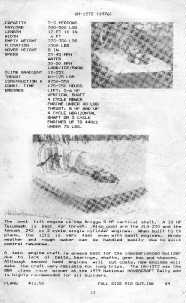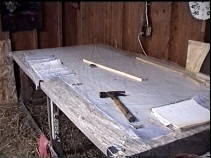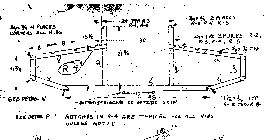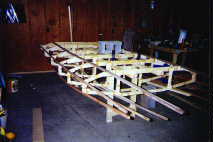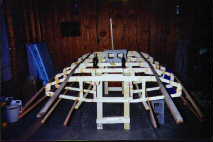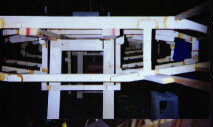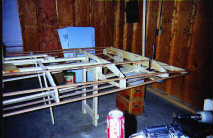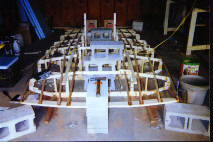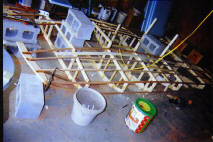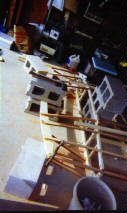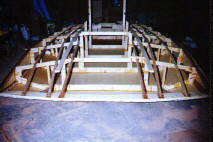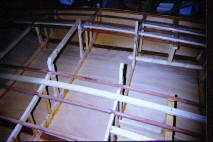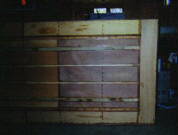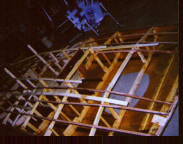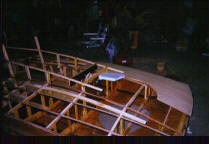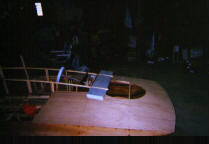Think about what size of hovercraft you want.
How many people?
Where are you going to fly it mostly: Lake, River, Field, Ice ?
How mechanically apt are you?
How much time to build.
I decided on 2 people, the river and a 2 engine craft. Here's a page from the UH catalog on the chosen UH12T2.
Now order the Plans. Be sure to get the full size rib drawing. (It's worth it.)
Until they arrive go ahead and clean out your workspace. You'll need at least a car and a half size space. I used half a 2 car garage that was deep enough to hold the hovercraft and a workbench. You'll need a workbench, if you don't have one, build one. I found a 4x8 sheet of plywood and some 2x4's make a table big enough to build all the ribs. Also if you don't have the basic woodworking tools, buy or borrow them. They will make the job easier with better results. The more tools the better but you can build it with just the basics. I would recommend these basic tools to get started: drill, jig saw, tape measure, t square, clamps and a router, table saw or sliding miter saw.
When the plans arrive, read them thoroughly. UH's Construction and operation booklet is good reading, several times. Decide which engines and size of props.
When you're ready, proceed to the local lumberyard and buy the lumber for the ribs. Take your time and look the lumber over well, most common lumber is crooked, warped and full of knots.
Lay the full size rib drawing on the workbench, cover with a thin sheet of plastic.
Time to make the ribs stage 1. Lay them out onto the rib sheet and do one joint at a time. Marking all the cuts at once doesn't work, if the first cut angle is a little off then the next joint angle is wrong. I lay out the bottom board, lay on top one of the side boards, mark and cut . Then lay on the next board, line it up with the plan, mark and cut again. On this 12t2 i used a router to remove 1/2 the board for the splice joint. On the 17t I'm currently building I'm using a sliding miter saw, its much easier, I think. I like to cut all but the bottom board an inch or two longer than needed, then trim the excess later with a router and trim bit. Once the joints are all cut, go ahead and glue. I used the Weldwood Plastic resin glue, it is very strong, waterproof and easy to mix and use. If you like epoxy go for it. One thing though, go ahead and buy 1/2 gal or gallon of epoxy, you will use alot of it later. Epoxies come in 2 different types, the polyester type will not bond to styrofoam which you'll be doing later, don't buy this type if you're buying the larger quantity of epoxy. On the other hand the polyester type epoxy resin works O.K. for wood to wood joints and is cheaper to use when sealing the bottom skin from inside (more on this later). I used a gallon of West Systems epoxy and 206 slow hardener, it worked well. A note of interest is that many glues are temperature sensitive, if you're building in the winter be sure to check the glue instructions. Try to get your joints good, but don't spend and inordinate amount of time. Small gaps can be filled with glue which is as strong as the wood. Below is a picture of Rib #4.
Once Stage 1 of 3 or all the ribs is completed its time for the overlap pieces. Take a piece of 1/8" plywood and cut a piece to match the joint, sand joint flat, and glue to both sides. Use some more nails or staples, but don't put the nails where the notch will be cut. Check the plans thoroughly. Clamp and let them sit until dry.
Now Stage 2 on the ribs. Sand flat and square all rib outer edges where applicable.
And Stage 3 cutting the notches. drain holes and extra bracing. I used a jigsaw the first time, I'm trying a 3/4 inch mortising bit on a drill press for the 17t. Don't just cut all the notches at 90 degrees, some of the stringers may meet the rib at an angle. Another thing to think about now are the extra braces for the area you'll be stepping on when getting in and out. You can do this later but consider how your going to accomplish this, you might want to cut few notches now while it easier to do so.
Now to make it look more like a hovercraft. It's time to put the stringers on the ribs. Try to find a long boards with virtually no knots or very small tight ones. I got lucky with several 16 ft. 1x6 pieces of redwood from a dusty loft of the lumberyard. They were completely free of knots. He charged me more than pine but not too much. If you get a good deal on good lumber, buy it. So much of the common lumber is crap, it makes it very hard to use strong boards. Obviously the better the lumber the stronger the hull. I didn't have a table saw for this project but I'm trying one now to rip some 1x6's. For this project a friend ripped all my stringers at 3/4" x 3/4" and I hauled them home tied to the side of the car:)
